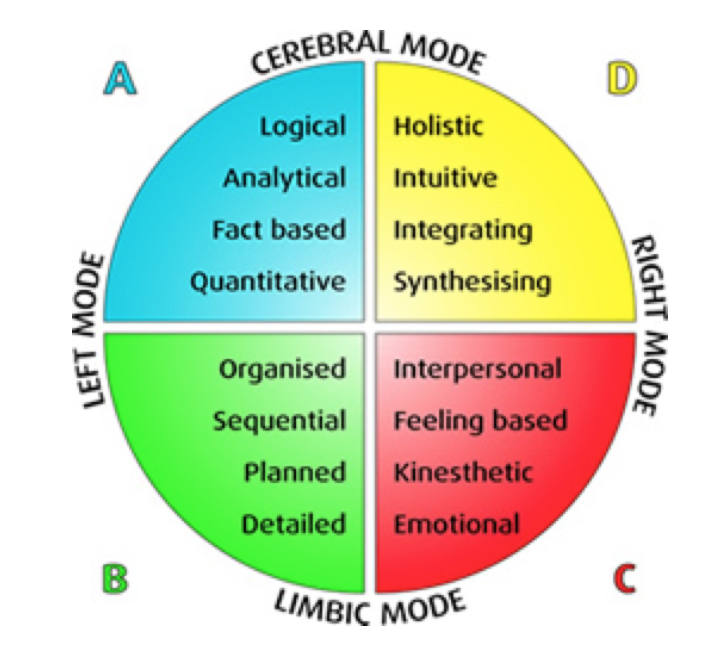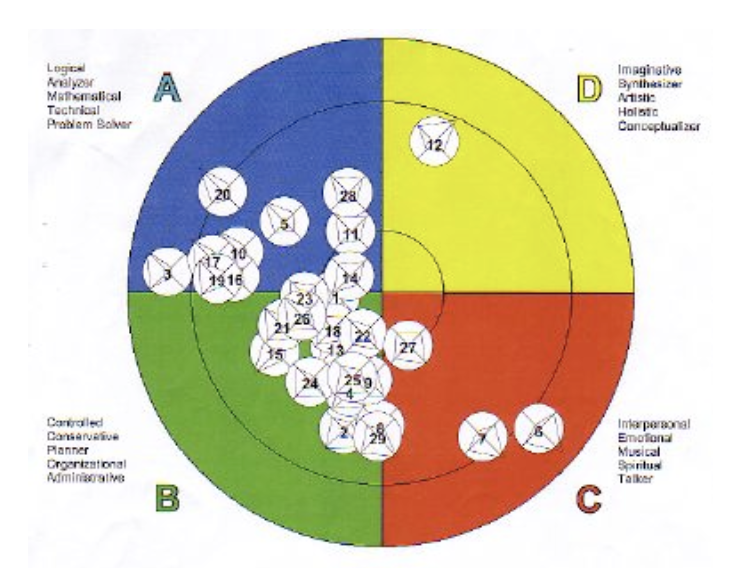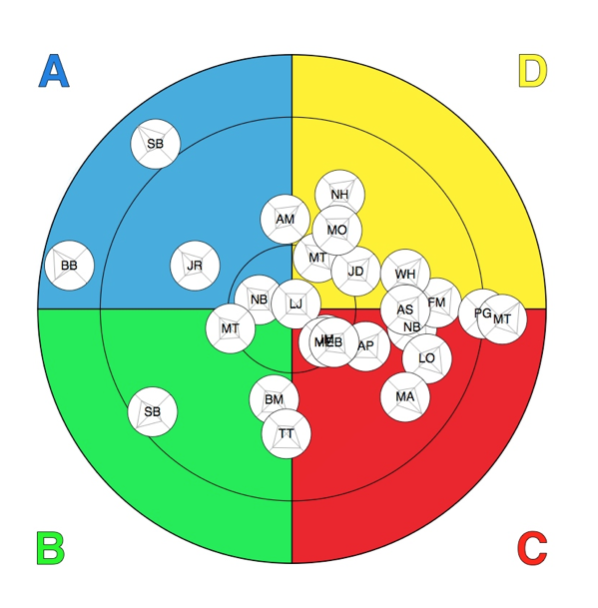
 |
| I write regular Strategic Snippets because I care about the success of your business. If you care about the success of someone else's business click "Send this page to a friend". Ask them to let me know that you were involved. |
Contact
Bruce Holland
| mob+6421 620 456 |
| Bruce.Holland@virtual.co.nz |
 |
WHERE ARE YOUR STRATEGIC BLIND SPOTS?
Most organisations are smart in some areas and almost blind in others. This is especially important when I’m working with them on strategy development; first because their strategic advantage depends upon building on their strategic smarts; and, second because their strategic survival depends on seeing pitfalls in the areas where they are blind. Both the smarts and the blindness are related to their thinking preferences.
Herrmann Brain Dominance Instrument (HBDI) is the best tool I know to measure thinking preferences. In the first chart the circle represents the brain. The left side of the brain (Quadrants A and B) understands the world through the five senses. The right side of the brain (Quadrants C and D) understand the world through the sixth sense (intuition). The top half of the brain (Quadrants A and D) favours ‘cerebral’ thinking processes. The bottom half of the brain favours ‘limbic’ or feeling processes. Therefore A Quadrant prefers left-brained thinking. B Quadrant prefers left-brained feeling. C Quadrant prefers right-brained feeling. D Quadrant prefers right-brained thinking.

Thinking preferences
Some organisations, where most of the people are accountants, engineers or statisticians, have a left-brained, thinking preference. As measured by HBDI, their smartness is factual and logical (A Quadrant) and their blindness is mostly about people, emotions and social aspects (C Quadrant).
Other organisations, where most of the people are administrative, librarians or project managers, have a left-brained, feeling preference. Their smartness is in the details, planning and procedural (B Quadrant) and their blindness is mostly about strategic, big picture and future aspects (D Quadrant).
The second chart is an example of a mainly A/B organisation.

Organisations, where the people are mainly architects, entrepreneurs or artists, have a right-brained, thinking preference. Their smartness is strategic, big picture, integrating and synthesising (D Quadrant) and their blindness is mostly administrative and procedural (B Quadrant).
Organisations where the people are mainly sales staff, social workers and nurses have a right-brained, feeling preference. Their smartness is people, emotions and social aspects (C Quadrant) and their blindness is mostly about factual and intellectual (A Quadrant).
The third chart is an example of a mainly C/D type organisation. I’m sure you can see how the two organisations (see second and third charts) would see differently and have quite different smarts and blindnesses.

Case study
The second chart was actually the profile of a team of accountants in a major organisation that delivers social services. As can be seen, most of the accountants were Quadrant A and most of the clerical people were Quadrant B. One person (the Finance Manager) was a Quadrant D. Two people (the Receptionists) were Quadrant C. The wider social services organisation and its Senior Managers were largely Quadrant C (more like the third chart).
The accountants had strong analytical skills and were some of the most educated people in the organisation so they had many of the answers to the most important problems in the organisation; however, because they were blind to interpersonal and communication insights, they couldn’t sell their ideas nor have the influence they deserved.
Before the strategy process the accountants would produce piles of technically sound data and spreadsheets, deliver these to the senior managers and wonder why no one took much notice. After the strategy process the accountants changed their whole delivery process. They still produced the same reports, then they analysed them to identify the three or four critical issues that needed attention and sat down around a table with each of the senior managers involved and discussed what it meant and what to do. The results were amazing!
Second, the accountants recognised that they were part of a largely Quadrant C organisation. Previously the rest of the organisation was somewhat fearful of the accountants who talked a different language and were seen as analytical, cold and uncaring. The accountants learned to make a few simple (Quadrant C) changes to their behaviours that made them more available to the organisation, more connected and more trusted.
The final benefit came from the accountants seeing their role in a bigger way (Quadrant D); instead of being ‘just a bean-counter’ (Quadrant B view) they started to see themselves as central to the organisation’s feedback process. As they understood the critical importance of feedback to the effective running of the bigger system, they extended the factors they measured to include indicators on knowledge and relationships. As their usefulness increased, they felt more significant and purposeful and they worked even harder at developing their financial smarts.
Bruce Holland
Virtual Group Business Consultants
Phone +6421620456 or Skype Bruce.Holland
www.virtual.co.nz
Go back to Index for Strategic Snippets
Key words: Leadership, leadership development, leadership management, leadership training, leadership program, leadership skills.


